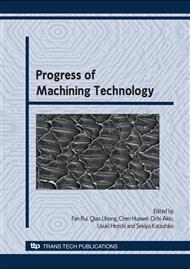p.41
p.45
p.49
p.53
p.59
p.63
p.68
p.73
p.77
Practical Measurement and Evaluation of Thermal Behavior of NC Lathe and its Application to Turning Process Modification
Abstract:
The measuring method for thermal effects in NC machine tools was drawn-up as ISO 230-3 in 2001. After that, this international standard was introduced as JIS B 6193 in 2003. In connection with this, the measurement of thermal effects becomes achievable also not only in a machine tool builder but in a user side. Therefore, in this research, practical measurement and evaluation of thermal behavior in CNC lathe are performed from a user's viewpoint. Primarily in the experimental measurement, the spindle speed required for turning of the workpiece for a trial-production was given as a load pattern. Then the thermal displacement between cutting tool and workpiece was measured based on the above-mentioned standard and the evaluation result was reported. Secondarily, the consideration was done for the modification of the turning process of the most influential thermal effect. The thermal behavior by applying the modified load pattern was re-measured successively, and comparative evaluation was carried out. As a result, it was verified that an extensive reduction of the thermal effects was possible in the sensitive direction to the accuracy.
Info:
Periodical:
Pages:
59-62
Citation:
Online since:
February 2009
Authors:
Price:
Сopyright:
© 2009 Trans Tech Publications Ltd. All Rights Reserved
Share:
Citation:


